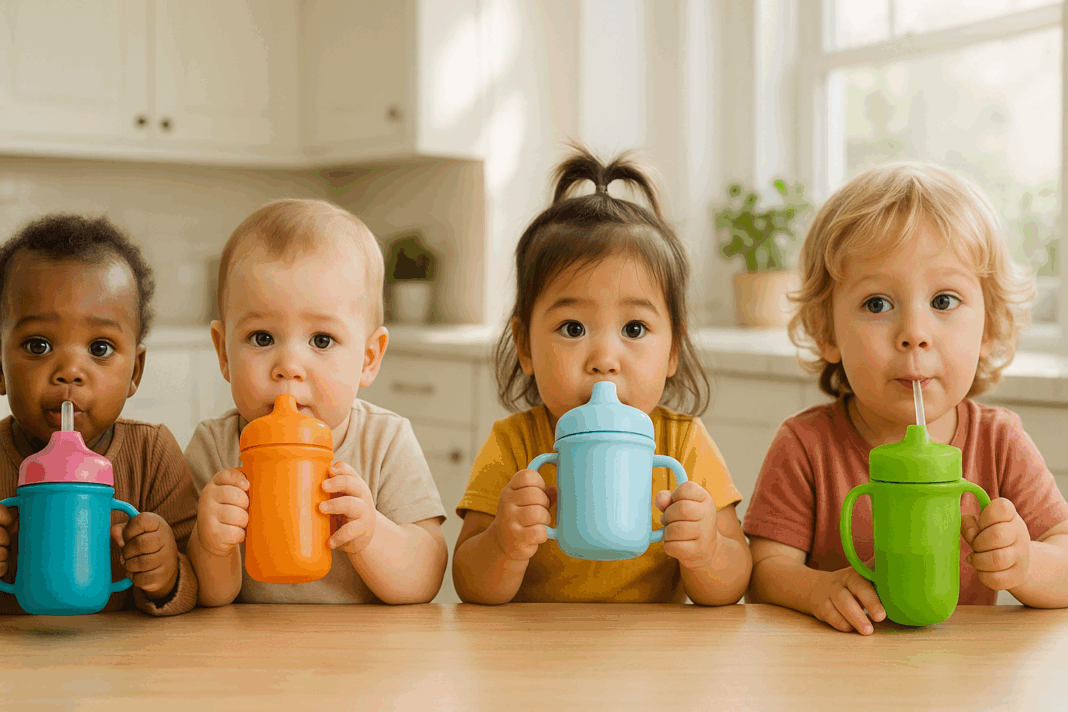Ensuring proper hydration is essential for every child’s growth and development, and the tools parents choose can significantly influence their children’s hydration habits. For many families, selecting the best sippy cup plays a pivotal role in this journey, especially when transitioning from bottle or breastfeeding to independent drinking. The right sippy cup not only promotes hydration but also supports oral motor development, hand-eye coordination, and even dental health. Yet with the vast array of options available—ranging from soft spouts and hard spouts to straw mechanisms and open trainer cups—choosing the ideal cup can be surprisingly complex. This guide delves deep into the practical, developmental, and health-related considerations that every parent should weigh when searching for the best sippy cup to support their child’s hydration needs and nutritional growth.
You may also like: Essential Milestones in Baby Led Weaning: A Proven Guide to Nurturing Healthy Eating Habits
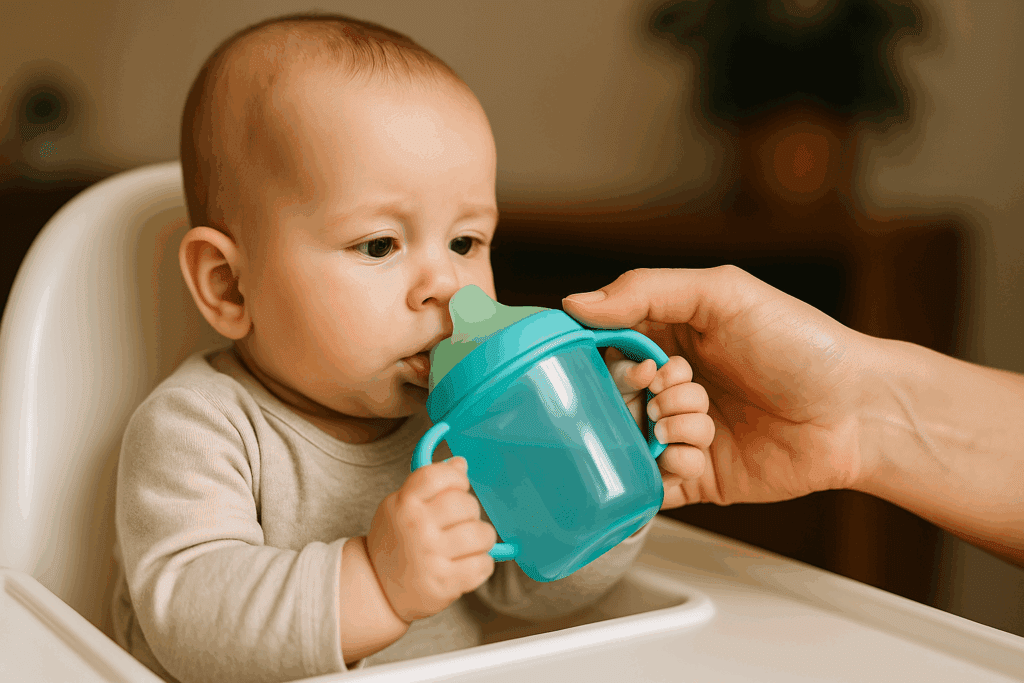
Understanding the Developmental Role of Sippy Cups
Introducing a sippy cup is more than a matter of convenience or reducing mess; it’s a developmental milestone that bridges the gap between infancy and toddlerhood. Around six months of age, many infants begin showing readiness for sippy cups, signaling a shift in feeding dynamics. This change often coincides with the introduction of solid foods and greater independence during meals. A well-designed sippy cup nurtures motor skills by encouraging the baby to grasp, tilt, and coordinate their mouth with the flow of liquid, all while limiting spillage.
More importantly, transitioning to a sippy cup supports orofacial development. Prolonged bottle use has been linked to dental issues such as malocclusion or delayed speech development due to persistent sucking patterns. In contrast, using sippy cups—particularly straw cups or spoutless designs—promotes healthier tongue positioning and stronger oral muscles. Parents aiming to make this shift should watch for cues such as the ability to sit upright with support, show interest in adult drinking behavior, or use their hands to hold objects. These signs can indicate that a baby may be ready for an infant sippy cup or other beginner-friendly options. In this developmental window, the best sippy cup for a 6 month old offers the right balance between safety, ease of use, and sensory engagement, laying the foundation for a positive lifelong relationship with healthy hydration.
How to Identify the Best Sippy Cup for Your Child’s Needs
Choosing the best sippy cup begins with an honest assessment of your child’s age, developmental stage, and specific needs. While all sippy cups aim to transition a baby from bottle or breast to independent drinking, not all are created equal in design, functionality, or health impact. For instance, the best sippy cup for a 1 year old typically features ergonomic handles, spill-proof valves, and a soft spout or straw that accommodates emerging teeth and sensitive gums. At this stage, toddlers are often exploring different textures and drinking rhythms, so a cup that can adapt to these changes is crucial.
For younger infants—especially around six months—the best infant sippy cup usually includes a silicone or soft spout that mimics the familiar sensation of nursing or bottle feeding. This helps reduce resistance during the transition period while still encouraging the gradual development of oral skills. On the other hand, as toddlers mature and gain more control, many families gravitate toward straw-based designs. The best straw cup for milk or water fosters a natural sucking pattern that supports healthy oral posture and reduces the risk of dental misalignment.
Material also plays a pivotal role in selecting the right cup. Parents are increasingly opting for BPA-free, phthalate-free plastic or stainless steel to reduce chemical exposure. Some even explore glass options with protective silicone sleeves. Regardless of material, a truly effective toddler cup should be easy to clean, resistant to mold buildup, and intuitive enough for children to use without assistance. By aligning cup features with your child’s unique stage of growth, you’re better positioned to find a solution that not only fits their hydration needs but also encourages developmental progress.
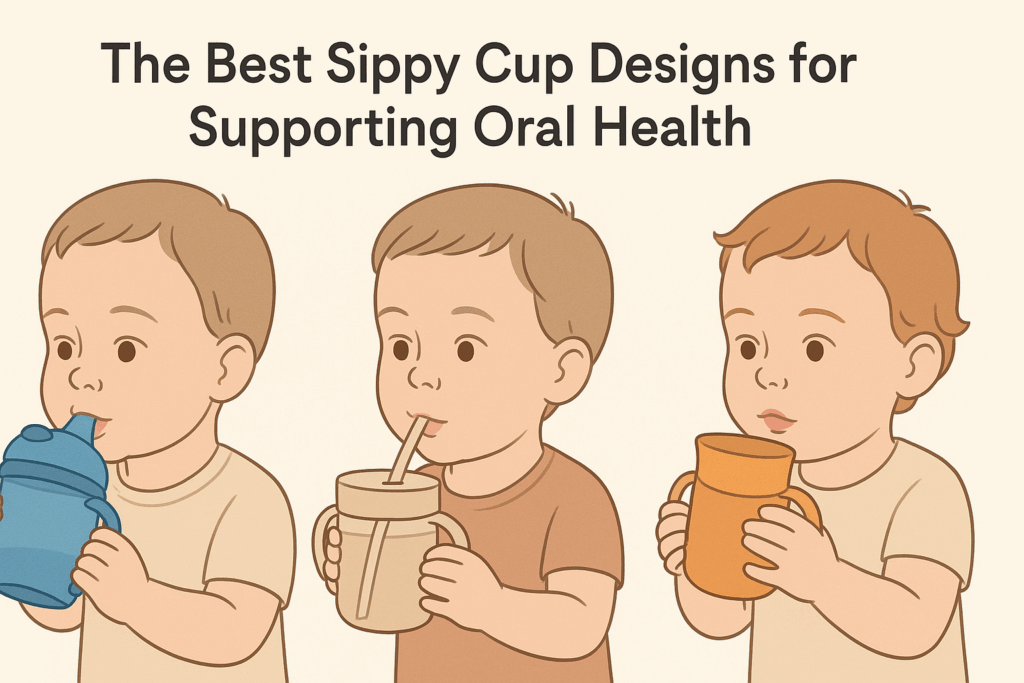
The Best Sippy Cup Designs for Supporting Oral Health
Oral development is an often-overlooked aspect of sippy cup selection, yet it can have lasting implications for speech, swallowing, and dental alignment. The American Dental Association recommends limiting prolonged use of traditional hard spout sippy cups, which can contribute to issues like overbite or tongue thrust. Instead, pediatric speech therapists and dentists frequently advocate for cups that mimic natural drinking patterns, such as straw sippy cups or open-trainer cups. The best straw sippy cup encourages a mature swallow and supports the development of lip, cheek, and tongue muscles.
When evaluating the best toddler cups for oral health, prioritize options that avoid excessive suction or promote continuous sucking. Instead, look for models that release liquid only when the child is actively drinking, helping to establish healthy oral habits. This is particularly important when offering milk or other calorie-dense beverages, as prolonged exposure can contribute to cavities. Therefore, the best sippy cup for milk should have a controlled flow, be easy to clean, and ideally be used during designated meal or snack times rather than being available throughout the day.
Parents may also consider alternating between different cup types as their child grows. For example, using a best straw cup for milk during meals and transitioning to an open-top trainer cup for water at other times can offer both developmental variety and oral stimulation. These diverse experiences promote muscle coordination and can even support the early stages of speech development. Thus, understanding the intersection between hydration tools and oral health can make a profound difference in a child’s growth trajectory and long-term well-being.
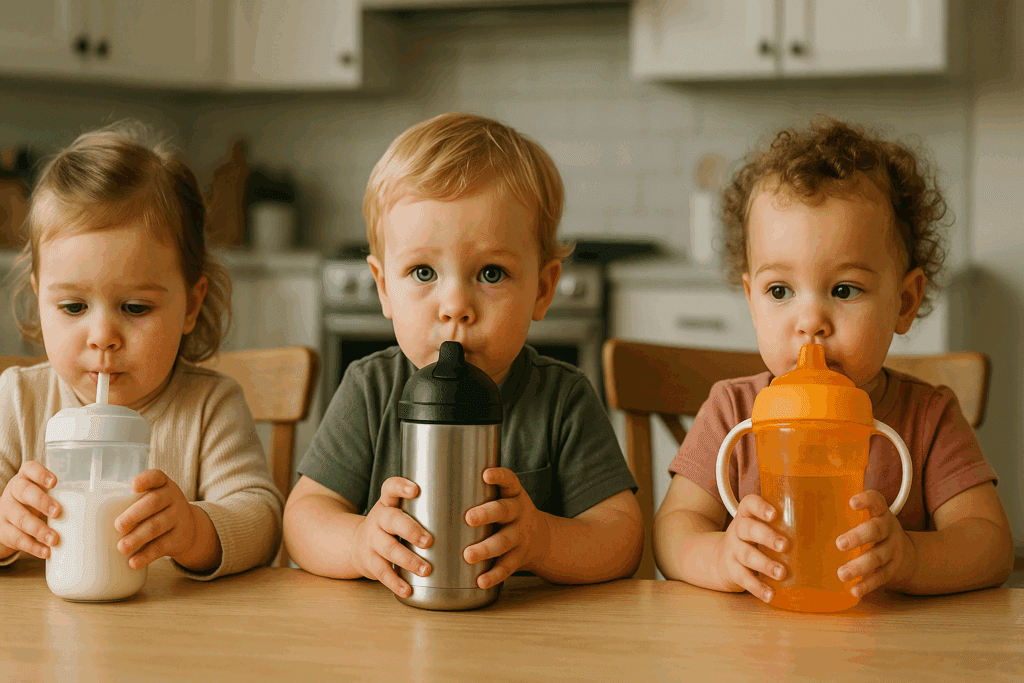
Choosing the Best Sippy Cup for Milk, Water, and Juice
Not all beverages are created equal when it comes to children’s hydration, and the type of liquid being consumed should influence the type of cup you use. Water remains the healthiest and most recommended beverage for children over six months, and any cup designed for water consumption should be leak-proof, durable, and encourage independent use. However, when milk or other thicker fluids are in the picture, parents must be more discerning. The best sippy cup for milk should have components that are resistant to residue buildup and easy to disassemble for thorough cleaning, as milk can sour quickly and harbor bacteria if not handled properly.
Straw cups are an excellent choice for milk, as they minimize pooling in the mouth and direct the fluid to the back of the tongue, promoting a healthier drinking posture. Similarly, the best straw cup for milk offers slow, regulated flow to prevent overwhelming young drinkers, especially those who are still mastering coordination. For juice—which should be limited and always diluted for young children—the best sippy cups include no-spill valves that help avoid sugar-related dental issues and reduce the risk of mess.
It’s worth noting that temperature can affect a child’s receptivity to drinking. Stainless steel cups that offer insulation may help keep milk cold longer, while some insulated plastic models are specifically designed to maintain ideal temperatures. Choosing the right materials and mechanics for each type of drink helps avoid unnecessary resistance during mealtimes, reinforces positive hydration habits, and ensures the nutritional integrity of beverages served. Ultimately, selecting the best sippy cup for baby nutrition depends not just on age and developmental readiness but also on the type of liquid offered and the context in which it is consumed.
Safety and Materials: What to Know Before You Buy
When selecting the best sippy cup for your child, safety is paramount—not just in terms of choking hazards or spills, but also in the materials used to manufacture the cup. As awareness about environmental toxins and endocrine disruptors has grown, so too has the demand for non-toxic, durable, and hygienic materials in children’s products. This shift is especially relevant for parents choosing the best cups for toddlers, where repeated exposure to substandard materials could affect long-term health outcomes. Among the most popular and trusted options are BPA-free plastics, medical-grade silicone, stainless steel, and borosilicate glass with silicone sleeves.
Each material comes with its own set of advantages and limitations. BPA-free plastic cups are lightweight and typically the most affordable, but they may degrade over time, especially when repeatedly exposed to heat from dishwashers or microwaves. Silicone is flexible and gentle on sensitive gums, making it a common choice for the best first sippy cup for infants. Stainless steel, on the other hand, is known for its durability and insulation capabilities, helping beverages stay cool or warm for longer periods. These cups are ideal for busy families who spend time outdoors or on the go. Borosilicate glass, while less common, is valued for its purity and resistance to chemical leaching, though its weight and fragility require careful handling.
In addition to materials, cup design plays a vital role in ensuring safety. Features such as anti-spill valves, dual handles, and weighted straws reduce the likelihood of choking and encourage independent use. Rounded edges, secure lids, and non-slip grips further enhance usability. When evaluating the best straw cups for infants, for example, parents should look for models that offer a soft, flexible straw that’s gentle on the gums yet robust enough to withstand teething pressure. All components should be easy to disassemble and dishwasher-safe, minimizing the risk of mold or bacterial growth. Ultimately, prioritizing both material integrity and safety design features helps ensure that every sip is both nourishing and secure.

The Best Sippy Cup Options for Different Age Milestones
Children’s developmental needs evolve rapidly, and so should the tools designed to support them. While a one-size-fits-all approach may seem convenient, it often fails to address the unique motor skills, oral needs, and hydration habits that emerge at each stage of early childhood. Therefore, identifying age-appropriate options—such as the best sippy cup for a 6 month old or the best cups for 3 year olds—can dramatically enhance both safety and developmental outcomes.
For infants around six months, the best sippy cup is typically one that closely mimics the familiar experience of nursing or bottle-feeding. These cups often feature soft silicone spouts or nipples with slow-flow valves to minimize gulping and aspiration. They also tend to be smaller in size, designed for tiny hands and limited fluid intake. At this age, hydration is more about exploration than consumption, and a well-designed infant sippy cup introduces the concept of self-feeding in a gentle, manageable way.
As babies become toddlers, typically around 12 months, their ability to manipulate objects and regulate fluid intake improves. The best sippy cup for a 1 year old often includes ergonomic handles, spill-resistant mechanisms, and durable materials that can withstand drops and throws. Many parents begin introducing straw cups at this stage, given their benefits for oral development. A weighted straw allows for flexibility in positioning, making it easier for toddlers to drink without needing to tilt the cup dramatically.
By the time children reach three years of age, their coordination and autonomy have progressed significantly. The best cups for 3 year olds usually resemble regular drinking vessels with subtle training features—like partially covered tops or flow-control valves—to bridge the gap toward open cup use. These cups should be large enough to meet increased hydration needs, yet lightweight enough for easy handling. Providing age-specific solutions at each milestone supports independence, minimizes frustration, and reinforces healthy hydration patterns as part of daily nutrition.
Why the Best Straw Sippy Cup May Be Better for Your Child
While traditional spouted sippy cups remain widely available, an increasing number of pediatric health professionals now recommend straw sippy cups as a more developmentally appropriate option. This preference stems from a growing body of research highlighting the long-term benefits of straw drinking on orofacial development, respiratory coordination, and swallowing mechanics. As such, selecting the best straw sippy cup can offer advantages that extend well beyond hydration.
Straw drinking encourages the tongue to stay in a neutral, low-forward position, which supports the proper development of oral and facial muscles. Unlike spouted cups, which can lead to prolonged tongue thrusting and altered jaw positioning, straw cups mimic the mechanics of drinking from an open cup without the associated mess. This is especially critical for children prone to speech delays or orthodontic issues, where oral muscle development plays a foundational role.
Parents often seek the best straw cup for baby or the best straw cups for 1 year olds when transitioning away from bottles, and the market offers numerous innovative designs to support this change. Weighted straws, spill-proof designs, and flip-top lids enhance both usability and hygiene, making these cups an excellent choice for active toddlers. Moreover, straw cups designed specifically for milk consumption—such as the best straw cup for milk—offer slow-flow technology that helps manage thicker liquids and prevent gagging or overconsumption.
It’s worth noting that transitioning to a straw cup may require a period of adjustment, particularly for children accustomed to sucking from a nipple or soft spout. In these cases, introducing straw cups gradually—perhaps beginning with water and progressing to milk or smoothies—can ease the transition. With the right cup and supportive guidance, straw drinking becomes not only a functional milestone but also a stepping stone toward healthier eating and speaking behaviors.
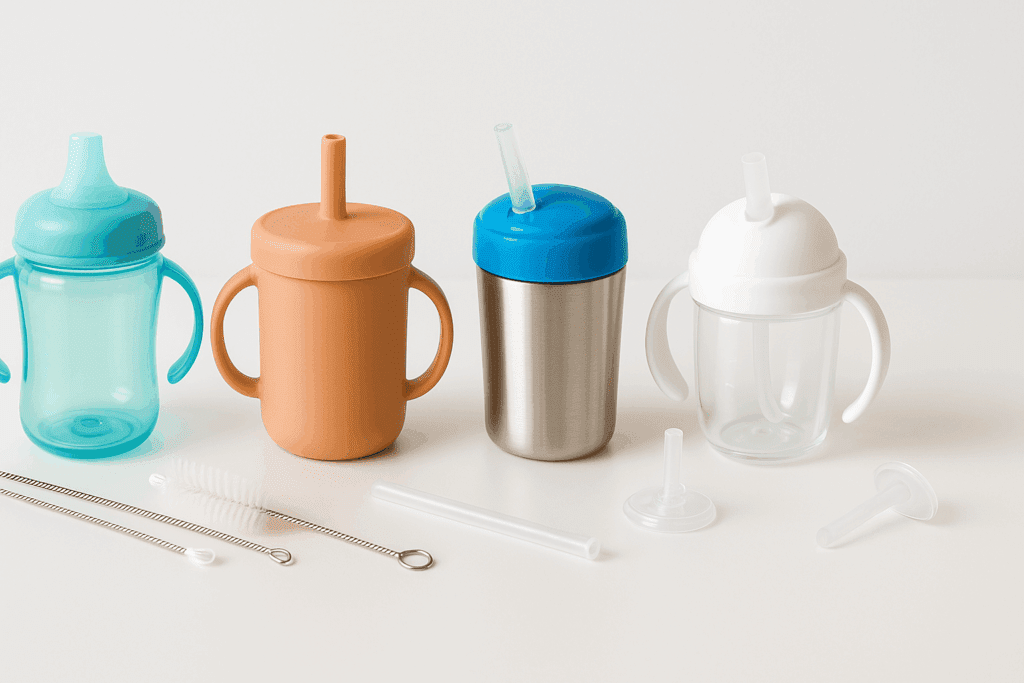
Exploring the Best Cups for Toddlers: Practical Features That Matter
When it comes to choosing the best cups for toddlers, practicality is key. While aesthetic appeal or character branding may capture a child’s attention, it is the functional features that ultimately determine the value of a cup in real-world use. For parents, the best toddler cups combine ease of use, spill resistance, and developmental support into a cohesive product that stands up to the daily rigors of family life.
One of the most important features is leak prevention. Toddlers are notorious for knocking over cups or shaking them vigorously, so the inclusion of non-spill valves or lids with tight seals is essential. Some of the best sippy cups for toddlers include smart valves that allow liquid to flow only when suction is applied, preventing messes without hindering the child’s ability to drink independently. At the same time, the design must avoid making sipping overly difficult, as excessive suction can lead to oral fatigue or frustration.
Handle design is another important factor. The best toddler cups often feature removable, textured handles that help children develop grip strength and hand coordination. For on-the-go use, features like flip lids or straw covers enhance hygiene and allow cups to be tossed into a diaper bag without leaking. Parents of older toddlers may also consider transitioning to trainer cups with spoutless tops that prepare children for eventual open-cup use, striking a balance between independence and structure.
Cleaning convenience should not be underestimated. Cups with multiple components or hard-to-reach corners can become breeding grounds for mold or bacteria, especially when used with milk or juice. The best sippy cup for milk, for example, should be easy to disassemble and safe for both handwashing and dishwashing. Look for cups that come with cleaning brushes or dishwasher-friendly parts to ensure hygiene without added hassle. In the end, a truly practical toddler cup supports not just healthy hydration but also family routines, reducing stress while enhancing nutritional outcomes.
When and How to Transition from Bottle to Sippy Cup
The transition from bottle to sippy cup is a major milestone in both nutritional and developmental terms. While the optimal timing may vary by child, most experts agree that introducing a sippy cup around six months and weaning off the bottle entirely by 12 to 18 months offers significant benefits. This transition helps prevent dental issues, supports speech development, and encourages autonomy in eating and drinking habits.
Introducing the best first sippy cup in a low-pressure setting—such as mealtime at home—can create positive associations. Begin by offering water or breast milk in a cup during regular feeding times, allowing the child to explore the sensation of a new mouthpiece and the mechanics of tilting or sucking. Many parents find success by modeling cup use themselves, drinking alongside their child to demonstrate technique. Repetition and praise are key components in building confidence during this phase.
It’s common for children to reject new feeding tools at first, especially if they’ve developed a strong attachment to the bottle. To ease this resistance, some families rotate between bottle and sippy cup over a period of weeks, gradually increasing the frequency of cup usage. Offering a variety of beverages—such as water, diluted juice, or milk—in the sippy cup can also maintain interest. If your child prefers certain textures or flow rates, choosing a cup with interchangeable spouts or adjustable valves can accommodate their preferences.
Consistency is essential. Encourage caregivers, daycare providers, and family members to follow the same practices to ensure a smooth transition. Keep in mind that while some children adapt quickly, others may take several months to fully make the switch. What matters most is establishing a pattern that supports oral development, minimizes sugar exposure, and reinforces the habit of independent, mindful drinking. With patience and the right tools, transitioning to the best sippy cup becomes an empowering step in your child’s journey toward healthy hydration.
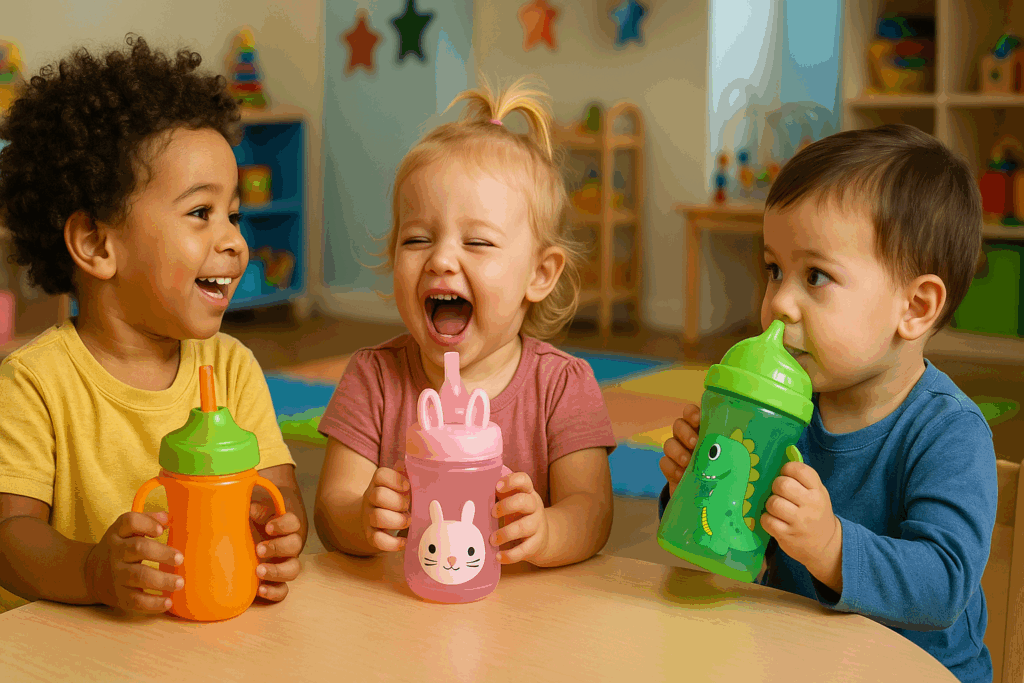
Cool Sippy Cups That Encourage Hydration Through Fun and Function
For children, especially toddlers who are developing strong opinions and preferences, the visual appeal of a cup can make a surprising difference in hydration habits. Cool sippy cups—those with bright colors, fun characters, or interactive features—often motivate children to drink more frequently and with greater enthusiasm. While aesthetics shouldn’t override safety or functionality, it’s entirely possible to find a cup that is both fun and developmentally beneficial. Parents who are strategic in selecting the best sippy cup can combine visual interest with essential features like spill-proof designs and ergonomic handles.
Some of the most successful cool sippy cups incorporate beloved cartoon characters, animal shapes, or changeable color designs that react to temperature or touch. These visual cues not only make the cup more engaging but can also serve as educational tools to teach color recognition, cause-and-effect relationships, and ownership responsibility. For example, a sippy cup that changes color when filled with cold milk may pique a child’s interest while subtly encouraging them to stay hydrated throughout the day.
Interactivity can also play a significant role in promoting positive hydration behaviors. Sippy cups with pop-up straws, twist-off lids, or built-in storage compartments for snacks create a multisensory experience. These features transform the cup into more than just a beverage container—they become part of the child’s mealtime ritual and personal space. The best cups for toddlers in this category strike a balance between novelty and practicality. While the design may be whimsical, the function should still support proper drinking posture, ease of cleaning, and long-term durability.
When choosing visually appealing sippy cups, it’s essential to verify that the materials used are food-grade and free from harmful chemicals such as BPA, PVC, and phthalates. While it’s tempting to prioritize design, parents should confirm that the cup meets international safety standards and has been tested for durability. Ultimately, the goal is to find a cup that excites the child without compromising health or hygiene—turning hydration from a chore into an enjoyable, self-driven activity.
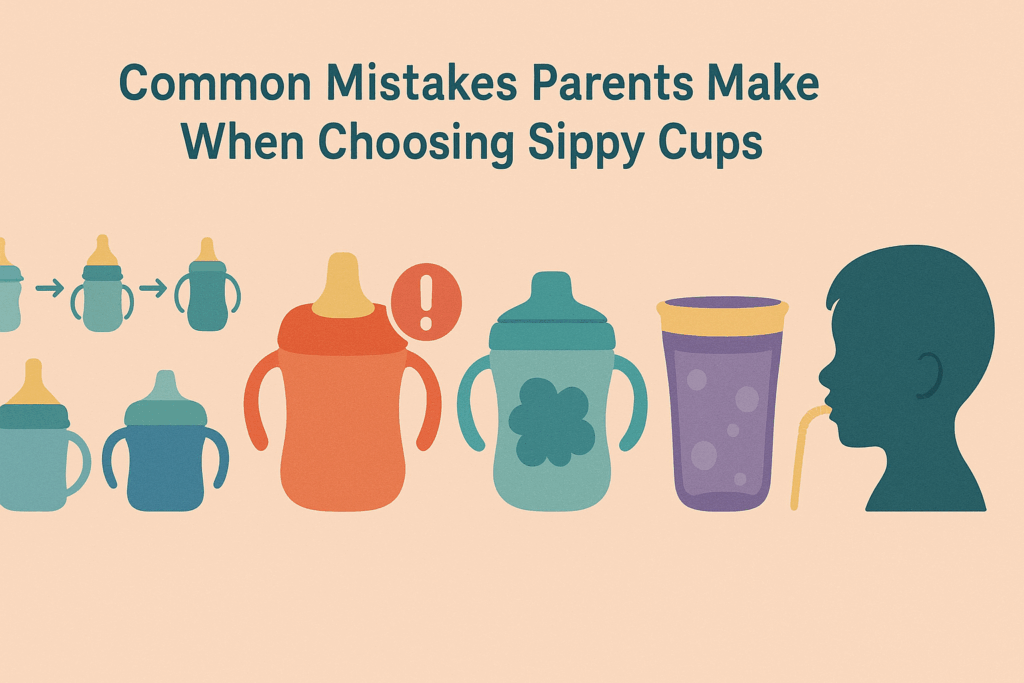
Common Mistakes Parents Make When Choosing Sippy Cups
Even with the best intentions, parents can fall into common traps when selecting a sippy cup for their child. These mistakes, while understandable, can lead to frustration, delayed development, or even potential health risks if left unaddressed. By identifying and avoiding these pitfalls, families can make more informed choices that truly support hydration, oral health, and independence.
One of the most frequent mistakes is delaying the transition from bottle to cup. Many parents wait too long, assuming their child isn’t ready or resisting the change to avoid conflict. However, prolonged bottle use—especially past 18 months—can contribute to dental decay, speech delays, and emotional dependency on sucking behaviors. The best sippy cup for baby use should be introduced around six months of age, even if the child only explores it at first. Early exposure builds familiarity, reducing resistance down the line.
Another misstep is over-reliance on traditional hard-spout cups. While they’re often marketed as the “standard” sippy cup, these designs may not support healthy oral development if used exclusively or for too long. Hard spouts can force the tongue into an unnatural position and inhibit the development of mature swallowing patterns. Parents searching for the best cups for 1 year old or best cups for toddlers should consider straw cups or spoutless trainer cups, which more closely replicate adult drinking and promote better muscle coordination.
Choosing cups that are difficult to clean is another widespread error. Sippy cups with multiple small parts, hidden valves, or textured interiors are harder to disinfect thoroughly, especially if used with milk or juice. Over time, residue buildup can harbor bacteria or mold, posing health risks. The best sippy cup for milk should disassemble easily and be dishwasher safe or come with specialized cleaning brushes for deep sanitation.
Lastly, many parents underestimate the importance of involving their child in the decision-making process. Offering choices—such as between two cup colors or designs—can foster a sense of autonomy and encourage more consistent use. This is particularly useful when transitioning from bottle feeding or when introducing new liquids such as smoothies or milk. Empowering the child builds enthusiasm, reduces power struggles, and supports long-term hydration habits rooted in personal agency and positive reinforcement.
Navigating the Overwhelming Market of Toddler Cups
Today’s market is saturated with choices, making the task of selecting the best toddler cups feel like navigating a labyrinth. There are brands that promise leak-proof technology, ergonomic design, and developmental support—but how many actually deliver on all fronts? For parents seeking the best cups for 3 year olds or the best straw cups for infants, the key is to cut through the noise and focus on research-backed features that align with both developmental science and everyday practicality.
One effective strategy is to focus on how the cup is used throughout the day. Some toddlers need a cup strictly for meals, while others require a portable option that travels well in the car, to daycare, or on outdoor adventures. For on-the-go hydration, the best straw cup for baby use will typically have a flip-top lid, weighted straw, and a durable structure that minimizes leaks even when tossed into a diaper bag. On the other hand, for sit-down meals at home, a spoutless trainer cup or an open-cup training design might be more appropriate, encouraging mature swallowing and offering a better transition to regular cups.
Parents should also consider the drinking habits of their child. Does your toddler sip slowly over time or gulp large quantities at once? Do they prefer chilled beverages like milk or room-temperature water? These nuances can guide you to choose between insulated stainless steel cups, traditional plastic cups, or silicone options with varied flow rates. The best sippy cup for milk, for instance, should support easy cleanup and temperature regulation to ensure safety and palatability throughout the day.
Brand reputation and user reviews can also offer valuable insights, but it’s important to read between the lines. Look for patterns in user feedback that highlight durability, ease of cleaning, and actual performance. Many parents praise specific brands for their innovative solutions to spillage or their child-friendly ergonomics. Cross-referencing these reviews with professional endorsements—such as pediatric dentist recommendations or speech therapist insights—can provide a more balanced picture.
In the end, the best sippy cups for toddlers are those that meet the child’s current developmental stage, suit the family’s lifestyle, and adhere to high standards of health and safety. This combination ensures not only that hydration is achieved but also that each sip contributes meaningfully to the child’s overall growth and independence.
The Role of Sippy Cups in Healthy Eating and Nutritional Development
Hydration and nutrition are often viewed as separate domains, but for young children, the tools used to consume fluids can influence broader eating habits and developmental progress. The best sippy cup is not merely a vessel for liquids—it’s a facilitator of healthy routines, meal structure, and sensory learning that complements the introduction of solid foods and balanced nutrition. Understanding how sippy cups play into a child’s nutritional journey empowers parents to foster healthy behaviors that last a lifetime.
At around six months, many infants begin exploring pureed foods, finger snacks, and different beverage types. Introducing a sippy cup at this stage offers more than just an alternative to the bottle; it creates opportunities for multi-sensory engagement at the table. By holding, tilting, and sipping from a cup, children develop fine motor skills and visual-spatial awareness that serve them well as they progress to utensils, self-feeding, and more complex meals. In this way, the best infant sippy cup helps bridge the gap between passive feeding and active participation in mealtime routines.
Meal timing and content are also influenced by the presence and design of the sippy cup. For instance, the best sippy cup for six month old babies may be used solely for water or breastmilk, whereas older toddlers might use specific cups for juice or milk. This division of purpose helps create boundaries around beverage types, reducing the likelihood of continuous snacking or excessive juice intake that can lead to obesity or dental caries. The best sippy cup for milk should be reserved for structured eating times, helping children associate it with meals rather than casual sipping throughout the day.
Sippy cups also contribute to the emotional landscape of eating. Children who feel successful and independent in their ability to drink are more likely to engage positively with food. Conversely, frustration with an ill-fitting cup or difficulty accessing fluids can dampen enthusiasm and lead to negative associations with nourishment. Selecting the right tool enhances a child’s confidence and sets the tone for cooperative mealtimes. In this regard, the best cups for 1 year old toddlers serve as more than a drinking aid—they become a core part of the child’s early relationship with food, health, and self-care.
Frequently Asked Questions About Choosing the Best Sippy Cup for Infants and Toddlers
What features truly differentiate the best sippy cup from average options on the market?
While many sippy cups may appear similar at first glance, the best sippy cup is distinguished by a carefully engineered design that supports both developmental milestones and practical needs. High-quality options often use medical-grade materials such as BPA-free silicone or stainless steel that hold up against frequent washing, drops, and temperature changes. Additionally, advanced spill-proof mechanisms that release liquid only upon suction help prevent messes without compromising ease of use. The shape of the cup, particularly the ergonomics of the handle and the contour of the spout or straw, can promote correct grip and oral development. In contrast, mass-market or low-cost alternatives may prioritize aesthetics over functionality, lacking essential safety standards or design features that promote long-term oral and motor health.
How does climate and regional lifestyle affect the choice of the best sippy cup for baby hydration?
Environmental context plays a more significant role than most parents realize when selecting the best sippy cup for baby hydration. In hotter climates or during summer months, children require more frequent hydration, making insulation features a key factor—especially for milk or smoothies. The best sippy cup for milk in these conditions is typically double-walled and stainless steel to keep contents cool while resisting bacterial buildup. In colder climates, straw cups may be preferable to hard spouts, as they allow for a more neutral oral posture without requiring the child to tilt their head back, which is less comfortable when bundled in winter gear. Additionally, rural families often prioritize rugged durability and easy-to-clean designs, while urban families may value lightweight, compact cups that fit easily into strollers or daycare cubbies.
What should I look for in the best straw cup for milk if my child is sensitive to textures or flavors?
Children with heightened sensory awareness can be particularly selective about the cups they use, and texture plays a significant role in their preferences. The best straw cup for milk for these children will use ultra-soft silicone straws that feel smooth on the lips and gums, mimicking the comfort of a bottle or pacifier without triggering aversions. Some options include temperature-indicating elements or slightly flavored materials to enhance acceptance, although these should be used cautiously to avoid dependency. Importantly, straw length and flexibility affect flow and suction effort—shorter, pliable straws often produce more consistent sipping experiences. Avoid rigid or plasticky straws, which can cause resistance and ultimately reduce milk intake. For sensory-sensitive kids, transitioning from a familiar feeding source to a new sippy cup must be gradual, ideally incorporating the same milk temperature and environmental cues during each introduction.
Are there advantages to having multiple types of sippy cups in rotation rather than relying on one model?
Absolutely, rotating between different types of sippy cups can offer a wide array of developmental, hygienic, and behavioral benefits. Each cup style supports different muscles and motor skills; for instance, the best straw sippy cup strengthens the tongue and cheeks, while open-trainer cups promote lip control and swallowing regulation. Using different cups throughout the day or week also ensures a more holistic range of oral stimulation and reduces the risk of over-dependence on any one sucking pattern. Moreover, having a designated best sippy cup for milk, a separate one for water, and perhaps another for smoothies or juice helps with hygiene and fluid variety. Changing up the cup also allows caregivers to evaluate preferences over time and adjust according to growth or specific needs such as teething or illness. This flexible approach enhances adaptability and confidence in young drinkers.
What long-term developmental benefits are associated with choosing the best cups for toddlers early on?
Making informed choices about the best cups for toddlers early in a child’s life may lead to long-term benefits in multiple domains, particularly oral health, speech clarity, and independent eating behaviors. By introducing straw or trainer cups over hard spouts, children are more likely to develop proper tongue positioning, which reduces the likelihood of lisps or articulation delays. Additionally, toddlers who use ergonomically designed cups often build superior hand-eye coordination and muscle control, which helps with other milestones like using utensils or brushing teeth. The best toddler cups can also reinforce mealtime structure and hydration habits, creating psychological cues that link drinking to nourishment and comfort rather than entertainment. These consistent routines build autonomy and reduce dependence on adult monitoring, easing transitions into preschool environments. Furthermore, choosing developmentally aligned cups can reduce future orthodontic intervention needs, lowering both stress and expense for families.
How can parents distinguish between the best sippy cup for 6 month old infants and those better suited for older toddlers?
Age-appropriate design is critical in identifying the best sippy cup for 6 month old infants versus those intended for more advanced drinkers. Cups for younger infants typically have softer, slower-flow spouts or straws to accommodate undeveloped oral muscles and reduce aspiration risk. These often include features like double handles for stability and transparent bodies that help parents monitor fluid intake. The best infant sippy cup will also be lightweight with a small capacity, as six-month-olds don’t need large volumes and may become discouraged by heavy or cumbersome cups. In contrast, the best cups for 3 year olds may have limited or no handles, faster flow rates, and larger reservoirs to support increased hydration needs during active play and mealtimes. They may also have open-style rims or removable lids to support progression toward standard cups. Understanding this progression allows for safer, more confident transitions across developmental stages.
What role does cup design play in parental confidence and consistency when using the best sippy cups for toddlers?
Cup design significantly impacts how consistently parents use and trust sippy cups during busy routines. The best sippy cups for toddlers are those that provide peace of mind through leak-proof reliability, easy assembly, and intuitive cleaning. When caregivers feel confident that a cup won’t spill in the car seat or harbor mold in hidden crevices, they’re more likely to stick with routines that include structured hydration. Consistency is key in reinforcing healthy drinking habits, and well-designed cups reduce the friction points—such as hard-to-remove lids or awkward straw angles—that discourage daily use. Additionally, user-friendly designs allow multiple caregivers (from grandparents to daycare workers) to follow the same procedures, maintaining uniformity in the child’s experience. Over time, these small but essential conveniences empower families to prioritize hydration without sacrificing time or sanity.
What are the most common misconceptions about straw cups for babies and how do they compare to spouted designs?
A widespread misconception is that straw cups for babies are inherently more difficult for infants to use, which leads many parents to default to spouted models. However, with proper design, the best straw cups for infants actually mimic the natural oral positioning used during breastfeeding, offering smoother transitions than hard spouts that demand unfamiliar mechanics. Another myth is that straw cups cause more mess; in reality, the best straw cup options feature leak-resistant valves that rival any spouted design. Moreover, straw cups provide superior benefits for developing tongue retraction, lip closure, and midline control, all of which are foundational to clear speech and safe swallowing. Unlike rigid spouts, straws also allow children to maintain a neutral neck posture, which promotes safer drinking while reducing strain on developing muscles. With a short learning curve and strong developmental payoffs, straw cups are increasingly seen as the gold standard in early cup training.
How do cool sippy cups influence children’s emotional connection with hydration and routine?
Cool sippy cups do more than entertain—they shape children’s emotional relationship with drinking routines and daily independence. A brightly colored cup featuring a beloved character can transform hydration from a chore into a celebrated part of the child’s day. This emotional connection is especially helpful during transitions, such as weaning from breastfeeding or adjusting to a new daycare environment. Children often perceive personalized or fun cups as their “special item,” which can enhance security, autonomy, and participation in self-care habits. For example, if a toddler associates their cool sippy cup with a reward or comfort ritual, they’re more likely to ask for it proactively, reinforcing consistent fluid intake. While aesthetics should never override functionality, integrating visual appeal can be a strategic parenting tool that makes establishing habits both joyful and sustainable.
Why does the best first sippy cup have such a strong impact on later cup use and hydration behavior?
The experience a child has with their first cup often sets the tone for how they approach hydration and feeding autonomy in general. If the best first sippy cup is comfortable, responsive, and well-matched to the child’s ability level, the child develops confidence and enthusiasm around drinking independently. On the other hand, an ill-fitting or leaky first cup can lead to frustration, refusal, or negative associations that are hard to reverse. Ideally, the best sippy cup for 1 year old beginners introduces drinking as an accessible and successful skill that complements emerging motor and cognitive abilities. It fosters a sense of ownership over health-related actions, helping to establish long-term patterns of self-care. Parents who carefully select the best sippy cup for six month old infants and continue making age-appropriate upgrades as needed are laying the groundwork for healthier, happier hydration habits well into childhood.
Conclusion: Choosing the Best Sippy Cup: Final Thoughts on Hydration, Development, and Parental Confidence
As we’ve explored throughout this comprehensive guide, selecting the best sippy cup is not just about minimizing spills or transitioning away from bottles—it’s a fundamental step in nurturing healthy hydration habits, supporting oral and motor development, and empowering children to engage in mealtime routines with confidence and independence. From the earliest days of infancy to the more self-directed years of toddlerhood, the right cup evolves alongside your child, adapting to changing needs, behaviors, and capabilities.
Parents seeking the best cups for toddlers should consider both short- and long-term goals. While spill-proof designs and character-themed cups may provide immediate appeal, developmental alignment and material safety are crucial for sustainable use. The best straw sippy cup, for instance, is more than a novelty—it’s a gateway to improved oral muscle strength, better swallowing coordination, and a reduced risk of dental issues down the line. Similarly, the best sippy cup for baby feeding routines must account for age-appropriate flow, ergonomic design, and sensory responsiveness that encourages exploration and growth.
When evaluating the best cups for 3 year olds or the best sippy cups for toddlers in general, it’s important to strike a balance between promoting autonomy and maintaining control over health outcomes. A three-year-old may gravitate toward a brightly colored cup with a pop-up straw, but parents should look beneath the surface to ensure that the cup’s construction supports healthy posture, regulates flow, and is made from non-toxic, BPA-free materials. The best toddler cups should serve as allies in your child’s growth—not just accessories.
Additionally, considering the type of liquid being consumed helps determine the optimal cup. Water, as the primary source of hydration, should be available throughout the day in a lightweight, easy-to-carry cup that encourages frequent sips. The best sippy cup for milk, on the other hand, must resist souring, allow for thorough cleaning, and be reserved for mealtimes to promote digestive regularity and oral health. Similarly, any cup used for juice should support portion control and be part of a broader effort to teach moderation and balanced nutrition.
Parents who take the time to research, experiment, and remain flexible with their approach will be rewarded with a child who not only drinks independently but also views hydration as a positive and self-guided activity. Whether you’re introducing your six-month-old to their first sippy cup or helping your toddler graduate to an open-top trainer, the journey is about far more than what’s in the cup. It’s about what the cup represents: growth, self-reliance, and a commitment to lifelong health.
In conclusion, the best sippy cup is one that aligns with your child’s developmental stage, supports healthy drinking mechanics, meets rigorous safety standards, and fits seamlessly into your family’s lifestyle. It should evolve as your child grows, providing just enough challenge to build skills while remaining accessible and enjoyable. From the best cups for 1 year old toddlers to the best straw cups for infants, and from cool sippy cups to practical, spill-proof designs for milk, each decision adds up. These small but intentional choices foster hydration habits that contribute to your child’s physical well-being, cognitive development, and emotional resilience.
Parents should feel empowered, not overwhelmed, by the process of choosing a sippy cup. With a clear understanding of what to look for—and a willingness to adapt as your child matures—you can approach this seemingly small decision with confidence. Every sip becomes a step toward growth, health, and the satisfaction of watching your child thrive. The best sippy cup is not just a product—it’s a powerful tool in the ongoing story of your child’s development, nourishing not just the body, but the skills and habits that will serve them for years to come.
Further Reading:
All You Need to Know While Choosing a Sippy Cup for Your Child


